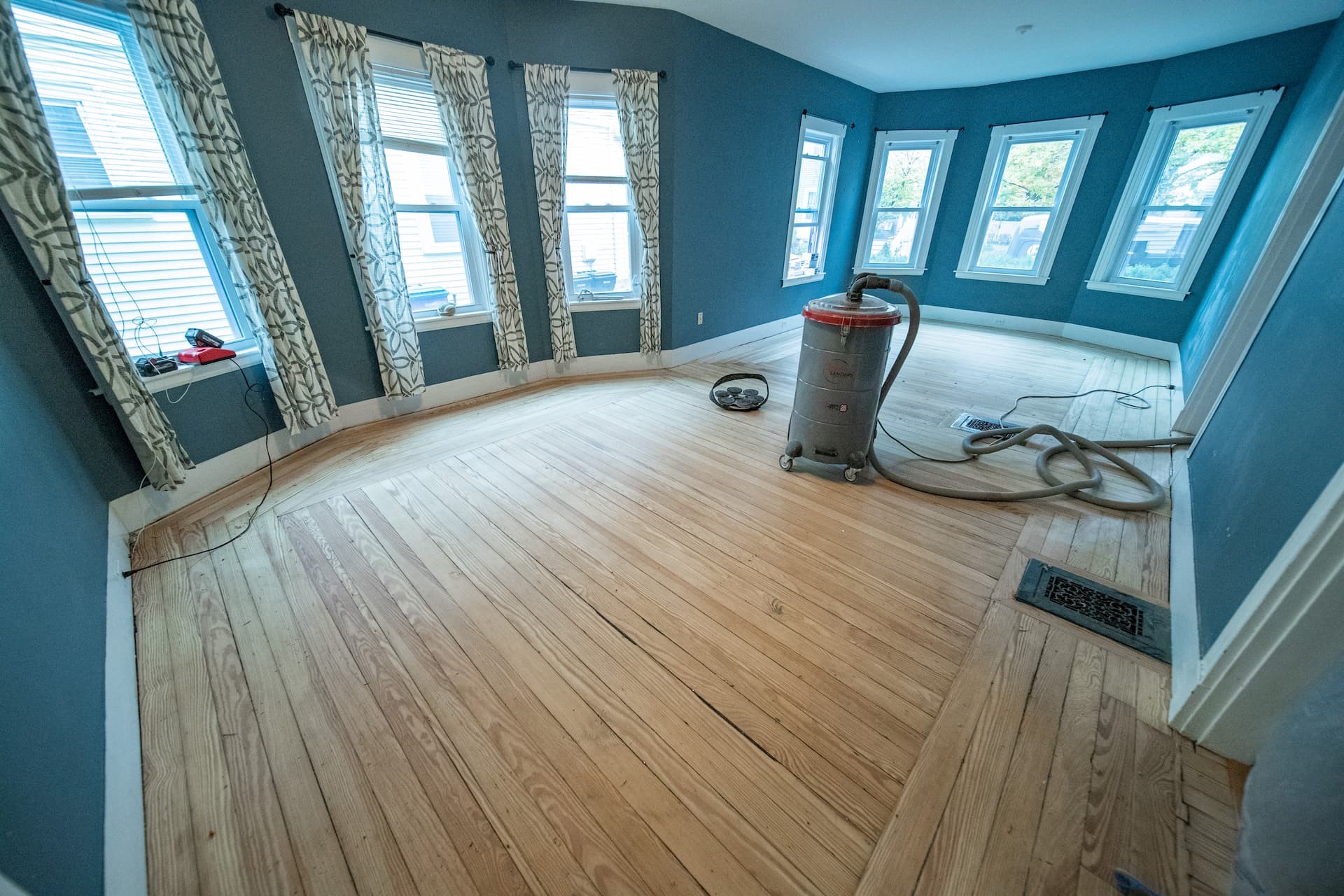⏳ Quick Answer:
After floor refinishing, you should stay out of your house for at least 3-4 days if oil-based finishes are used, due to longer drying times and stronger fumes. For water-based finishes, it's advisable to wait at least 2 days. This ensures the floors have properly dried and cured, and that any harmful fumes have dissipated for your safety.
Refinishing your floors is like giving your house a little refresh. It gives those beaten-down wooden surfaces new life, guaranteeing that they look just as clean as they did when they were initially put in. However, there's more to floor refinishing than meets the eye, just as with most domestic maintenance duties. In addition to the aesthetic appeal, homeowners frequently struggle with a number of issues: "How long should I wait before walking on my newly refinished floors?", "Are the fumes harmful?", and the most pressing one, "How long should I stay out of my house after the refinishing process?".
We'll go into much more detail about these concerns in this detailed work, providing anyone wishing to start this home renovation journey with clarity and peace of mind. This post promises insights that will make the procedure easier and safer for you and your loved ones, whether you're a refurbishing veteran or a novice.
The Refinishing Process: A Quick Overview
The art of refinishing a floor is more than just putting on a new finish coat. When done right, it’s a tricky procedure that can utterly transform a room. But what exactly occurs during this transition? Let's deconstruct it:
-
Assessment and cleaning: Before you start refinishing your floor, you need to check its condition. To do this, inspect it for dents, scratches and worn areas. Then wash the floor with soap and water to remove all dust, dirt and remnants of the old flooring.
-
Sanding: The first step in restoring a floor is sanding, which smooths the surface and removes the old finish. Professionals also sometimes use different types of sandpaper, from coarse to fine, depending on the condition of the floor.
-
Staining (Optional): Staining is the best helper if you want to change the shade of the wood or emphasize its natural hue. It is applied after sanding but before final finishing. Homeowners can choose from staining options ranging from light oak to deep mahogany shades.
-
Finishing: This finishing step adds a layer of toughness and luster to flooring. Polyurethane with an oil- and water-based base are the two main finishes. While water-based polyurethane dries quickly and is environmentally friendly, oil-based polyurethane produces a rich, glossy appearance.
-
Drying and Curing: The waiting game starts after the finish has been applied. To ensure that the floors are resistant to normal wear and tear, they need enough time to dry and cure.
Understanding this procedure is crucial for establishing reasonable expectations as well as for knowledge's sake. In order to achieve the finest results, homeowners must allot time for drying and curing in addition to the time that experts spend working on the floors. Learn More.
The Dangers of Polyurethane Fumes
Because of its protective properties and glossy sheen, polyurethane is a popular finish used in floor refinishing. It does, however, come with a unique set of warnings, just like many chemical items. When applied, polyurethane emits fumes that, if inhaled in significant doses or for a sustained period of time, may be hazardous.
- Immediate Effects: Polyurethane fumes can irritate the eyes, nose, and throat when first inhaled. Some people may feel lightheaded, woozy, or even have trouble breathing. To reduce these rapid effects, it's crucial to make sure there is adequate ventilation both before and after the application.
- Chronic Exposure: Prolonged exposure to toxic gases, particularly in inadequately ventilated spaces, might result in more serious health problems. These include allergic responses, breathing issues, and, in severe cases, liver and kidney damage.
- Groups at Risk: Children, the elderly, and those who already have allergies or respiratory disorders are especially vulnerable to the negative effects of polyurethane fumes. They must be kept away from the refinishing site until it is completely secure.
- The Crucial Question: Can Fumes From Polyurethane Kill You? Deaths from polyurethane fumes are relatively rare, despite the fact that they are poisonous and can have negative health effects. However, it's crucial to exercise respect for and be cautious around the gases. The hazards can be considerably reduced by ensuring enough ventilation, using protective clothing while applying, and leaving the house for the advised period of time.
In conclusion, while polyurethane is great for refinishing floors, it must always be applied safely. Knowing the risks and adopting the right precautions can help you reap the rewards of a refinished floor without endangering your health or safety.
😷 Tip: Always wear a respirator mask and ensure proper ventilation when working with polyurethane to minimize exposure to harmful fumes.
Recommended Time Out of the House
Homeowners may be tempted by the attractiveness of recently refinished floors and eagerly step upon their glistening surfaces. But in this case, patience isn't simply a virtue—it's a necessity. The length of time you should avoid entering your home after refinishing mostly depends on the finish used:
1. Finishes with an oil base:
Oil-based polyurethane often dries more slowly than its water-based cousin. It's best to wait at least 24 hours before wearing socks and walking on the floors.
- Full Cure: It's advised to wait at least 72 hours before moving furniture back in, even if you might be able to walk on the flooring after just one day. This guarantees that the finish has sufficiently hardened.
Ventilation is essential both during and after application of oil-based finishes due to the greater fumes they produce. For maximum safety, open windows, turn on fans, and think about leaving the house for three to four days.
2. Finishes Made of Water:
Water-based polyurethane dries more quickly, permitting homeowners to walk on the floors (while wearing socks) in as little as 6 to 8 hours after application.
- Full Cure: Despite the fact that the first drying time is shorter, it is still advised to give the floors at least 48 hours to fully cure before moving any furniture.
Ventilation is still necessary despite the fact that water-based coatings emit less strong fumes. Generally speaking, it is advised to leave the house for at least two days.
🕒 Tip: Patience is key! Waiting the recommended time ensures your floors cure properly, leading to a durable and beautiful finish.
3. Relevant Practical Factors:
Temperature and relative humidity can affect how quickly things dry. Warmer temperatures may hasten drying, whereas higher humidity may delay it.
- Foot Traffic on the Floor: Restricting foot traffic, especially in the first few days after refinishing, can help avoid unintended scratches and provide a uniform finish.
- Animals and Kids: Think about their curiosity and safety. It may be better to keep kids away from the area that has been refinished for a while, making sure the floors are completely fume-free and hardened.
In conclusion, while it is normal to be excited about your newly renovated flooring, its beauty and endurance are actually ensured by the patience shown during the curing process. Always err on the side of caution when in doubt.
Practical Tips for Homeowners
In order to achieve the finest results while refinishing floors, homeowners must participate as well as professionals. Here are some helpful pointers to remember both during and following the refinishing process:
1. Cleaning the House:
- Ventilation is Important: Always make sure the home is properly aired throughout the refinishing process and for a few days after. The vapors dissipate more quickly as a result of this.
- Utilize fans wisely: Place fans next to windows to expel odors and let fresh air in. Aiming fans directly towards wet floors should be avoided as this can lead to uneven drying.
2. Strolling through newly finished floors:
- Soft Steps: To prevent leaving traces of your footsteps or producing scratches, wait until the recommended drying time has passed before walking on the floors.
- Avoid Shoes: For at least a week after refinishing, avoid wearing shoes, particularly high heels or other footwear with hard bottoms.
3. Refinished floors and pets:
- Temporary Relocation: Take into account boarding your animals with a friend or a kennel while the refinishing is being done.
Before allowing your pets to wander free, wait for the flooring to fully cure to avoid paw prints and scratches. Their paws might leave prints on uncured finishes, and their nails might harm surfaces.
4. Home decor and furniture
Refrain from decorating right away and hold off on moving your furniture back. To make sure the finish is tough and durable, wait the necessary amount of time for curing.
- Utilize guards: To avoid scuffs when repositioning furniture, place felt guards under the legs.
5. Maintenance and Cleaning
Use a gentle towel or mop to clean the floors during the first several weeks. Avoid using wet mops or any harsh chemicals.
- Regular Maintenance: To keep your refinished floors looking good and of high caliber, think about giving them periodic washing with products made for hardwood floors.
In the realm of floor refinishing, a little bit of expertise, care, and patience go a long way. Homeowners may make sure their floors are lovely and enduring for years to come by using these useful ideas.
🛠️ Insight from Weles: "One thing homeowners often overlook is the impact of humidity on the curing process. We always advise using dehumidifiers in more humid climates to help the finish set correctly. It's these small steps that make a big difference in the longevity of your floor's finish."
Real-life Experiences and Recommendations
Refinishing floors involves a journey that many people have taken before. Here are some common experiences drawn from online discussion boards like Houzz and Reddit:
- Due to the potent fumes, many homeowners stress how important it is to leave the house while polyurethane is being applied.
- Some people have stayed in their homes throughout the process, but they advise against it due to the unpleasant stench.
- It is generally agreed upon that appropriate ventilation should be maintained for both health and drying purposes.
Additional Considerations
There are more factors to take into account outside the immediate refinishing concerns:
- Long-Term Effects of Fumes: Off-gassing can last for weeks even though the initial strong polyurethane odor quickly fades. Even after arriving home, sufficient ventilation must be maintained.
- Toxicity Issues: Polyurethane is typically regarded as harmless once it has dried. Pets and kids must be kept away, though, as it can be dangerous if consumed while it's still wet.



